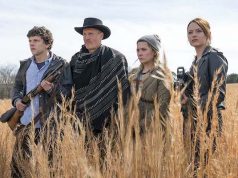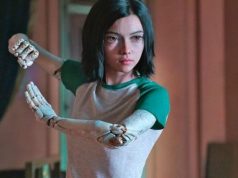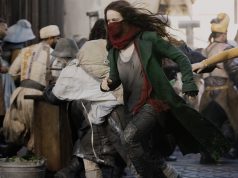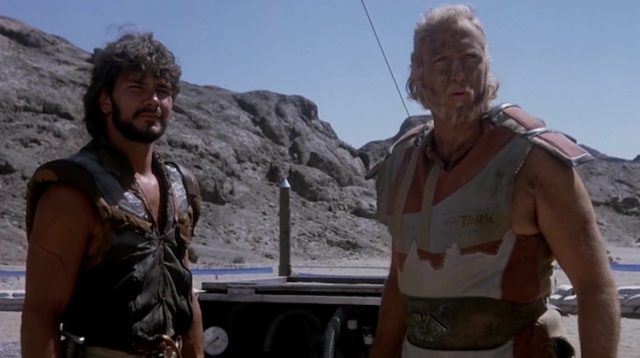
One of our favorite pastimes is imagining what things will be like after the inevitable breakdown of society and the annihilation of most of the world’s population. It is fun to speculate about our doom! Wheee! This was especially popular in the 1980s, when the Cold War made nuclear destruction seem possible, and the continued success of Duran Duran made it seem desirable. Among the hundreds of post-apocalyptic films made during that era is “Steel Dawn,” a brooding, dull-witted affair starring one Patrick Swayze. It came out when “Dirty Dancing” was still in theaters, and was intended to capitalize on Swayze’s new stardom by promising to show him being “dirty” some more, but unfortunately they only meant it literally, i.e., he is covered in dust the whole time.
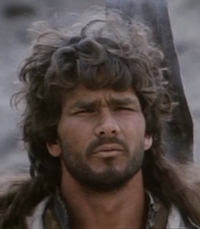
Like a lot of movies, “Steel Dawn” begins with Patrick Swayze standing on his head in the desert and then fighting some mutants who pop up out of the sand. What are these creatures? What is the object that they’re trying to take from Patrick Swayze? What is Patrick Swayze’s character’s name? No one would blame you for assuming that the movie will answer these questions in the next few minutes, but unfortunately the movie does not answer them, ever. The mutants are never mentioned again, whatever they were after is not discussed, and when someone later asks Patrick Swayze what to call him, he says, “Whatever you like, I’m not particular.” That is a good way to respond to a simple “What’s your name?” question, if you are an a-hole. Anyway, nobody ever addresses him by name throughout the movie, so let’s assume his name is Patrick Swayze.
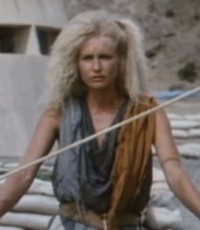
After fighting the sand people, Patrick Swayze trudges across the dunes for a while, finds a random German shepherd to be his friend, and eventually comes to a small outpost. (The dog appears in two or three scenes later on but is never part of the story, nor is its sudden appearance in the middle of the desert explained.) This outpost, consisting of a few small structures in a barren wasteland of desert, is a farm, supposedly, run by a hairful woman named Kasha (Lisa Niemi) — whom you should call Ke$ha — who looks like a Def Leppard groupie (or possibly a member of Def Leppard). Ke$ha calls her property a “purification farm,” suggesting it is involved in the important post-apocalyptic work of maintaining a clean water supply, but at no point does the movie give us a glimpse of what actually goes on here. Laborers just stride around purposefully, tweaking pipes with wrenches and giving the impression that they are busy with chores. Ke$ha asks Patrick Swayze if he’s ever worked on a purification farm before, and he says he hasn’t but he’s a quick learner, which I guess just means that he can walk around pretending to do stuff as well as the next guy.
As you may have noticed, attention to detail is not the movie’s strong suit. Making Patrick Swayze squint at people is the movie’s strong suit. But by listening carefully, we are able to discern a few basic facts about this world: there was a war that decimated the population; Patrick Swayze was a soldier in it; now civilization is in tatters. Are people living in the desert because every other place is even more uninhabitable? Or is this what the entire world looks like now? Those are good questions! Hang onto them in case the filmmakers do a Q&A afterward!
Turns out Ke$ha and her “purification farm” are part of a larger community that consists of other outposts that are all miles apart from each other. Somewhere in the middle is the equivalent of a town square and a marketplace. Why is everyone so spread out? Wouldn’t it be much easier to combat the awful heat and lack of resources, not to mention communicate with one another, if they clustered together? More good questions! This is going to be a great Q&A.
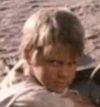
Anyway, this so-called community is harassed by a villain named Damnil (Anthony Zerbe) who goes around with his goons threatening everybody with violence if they don’t do what he says. It is clear that Patrick Swayze will have to fill the role of the quiet stranger who saves the people from an oppressive tyrant, as previously seen in Western movies (all of them). This means he will also have to sleep with Ke$ha, which he does, and act as a father figure to her young son, Jux, whose dumb name is matched by the snotty look he always has on his face. Ke$ha reveals to Patrick Swayze that just below her “purification farm” is a vast natural spring that could irrigate the entire valley forever. She plans to build an aqueduct to facilitate this. But if this huge reservoir is only a few feet under the ground, why is water so scarce up top? What is Ke$ha waiting for? Is this where the water that’s allegedly being purified at her “purification farm” is coming from? If so, where does everyone think it’s coming from, since the spring is a secret? Again, please hold your questions until the end. I’m starting to suspect they aren’t going to be answered, but I am tired of hearing them.
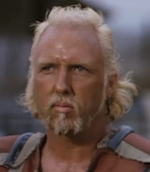
The movie keeps going for a while without justifying why it’s still going. Patrick Swayze tries to be a good role model for young Jux by beating up jerks who cause trouble in the marketplace. Patrick Swayze takes a bath in a washtub, for the ladies. Damnil’s goons vandalize one of Ke$ha’s pumps in the dead of night, so Patrick Swayze and Ke$ha’s foreman, Tark (Brion James), who has Hulk Hogan hair, steal a pump back from Damnil, which is also a good lesson for the kids about making a right, and how two wrongs will do it.
Now the movie has run into a problem. It has a very simple plot, so the only way to stretch the material into 90 minutes is to spend some time with the characters and watch them inhabit their strange, futuristic world. But the movie also has very simple characters who are devoid of personality and are not fun to spend time with, and the movie has also refused to set up their strange, futuristic world in any kind of detail. The movie might just as well have dropped a few rag dolls into an empty cardboard box and asked us to observe them for an hour.
Patrick Swayze eventually administers frontier justice and saves Ke$ha’s imaginary farm, whereupon he declares that he reckons he’ll be moseyin’ along now. “I don’t belong here,” he says. The people who made the movie had clearly seen a lot of Westerns where the quiet stranger leaves town after saving the day and wanted to include that component here, to make “Steel Dawn” seem like a real movie. What they overlooked is that in those other films, the quiet stranger usually has a reason for leaving. Patrick Swayze has never mentioned any friends, family, goals, or obligations. Here he has food, water, shelter, a girlfriend, and a snot-faced little boy who idolizes him. Everyone in the area is as grime-covered and as fond of fighting as he is. If Patrick Swayze doesn’t belong here, he doesn’t belong anywhere. And frankly, a post-apocalyptic world that has no place for a Patrick Swayze is not a post-apocalyptic world I want to live in.
(Note: In keeping with the film’s primary theme of never explaining anything, the title “Steel Dawn” is never explained.)
— Film.com


